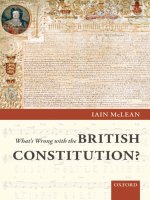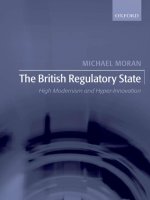- Trang chủ >>
- Khoa Học Tự Nhiên >>
- Vật lý
the british constitution dec 2007
Bạn đang xem bản rút gọn của tài liệu. Xem và tải ngay bản đầy đủ của tài liệu tại đây (1.74 MB, 450 trang )
THE BRITISH CONSTITUTION
This page intentionally left blank
The British Constitution
ANTHONY KING
1
3
Great Clarendon Street, Oxford ox2 6dp
Oxford University Press is a department of the University of Oxford.
It furthers the University’s objective of excellence in research, scholarship,
and education by publishing worldwide in
Oxford New York
Auckland Cape Town Dar es Salaam Hong Kong Karachi
Kuala Lumpur Madrid Melbourne Mexico City Nairobi
New Delhi Shanghai Taipei Toronto
With offices in
Argentina Austria Brazil Chile Czech Republic France Greece
Guatemala Hungary Italy Japan Poland Portugal Singapore
South Korea Switzerland Thailand Turkey Ukraine Vietnam
Oxford is a registered trade mark of Oxford U niversity Press
in the UK and in certain other countries
Published in the United States
by Oxford University Press Inc., New York
© Anthony King 2007
Themoralrightsoftheauthorhavebeenasserted
Database right Oxford University Press (maker)
First published 2007
First published in paperback 2009
All rights reserved. No part of this publication may be reproduced,
stored in a retrieval system, or transmitted, in any form or by any means,
without the prior permission in writing of Oxford University Press,
or as expressly permitted by law, or under terms agreed with the appropriate
reprographics rights organization. Enquiries concerning reproduction
outside the scope of the above should be sent to the Rights Department,
Oxford University Press, at the address above
You must not circulate this book in any other binding or cover
and you must impose the same condition on any acquirer
British Library Cataloguing in Publication Data
Data available
Library of Congress Cataloging in Publication Data
Data available
Typeset by SPI Publisher Services, Pondicherry, India
Printed in Great Britain
on acid-free paper by
Biddles Ltd., King’s Lynn, Norfolk
ISBN 978–0–19–923232–1
ISBN 978–0–19–957698–2
13579108642
For Jan, with love and hugs
This page intentionally left blank
Preface
This book seeks to do for the British constitution at the beginning of the
twenty-first century what Walter Bagehot did for what he insisted on calling
the English constitution during the latter part of the nineteenth century.
Bagehot thought the working constitution of his time was not altogether what
people thought it was. This book seeks to demonstrate the same proposition.
It sets out to describe the traditional British constitution and to show how
it has changed and why. It also explores the implications and consequences
of the changes that have taken place. They seem to me to have been, and to
continue to be, profound.
A word is probably called for about the style in which the book is written.
Most writing about the British constitution, especially most academic writ-
ing, is somewhat po-faced. The constitution is a serious matter, and people
therefore seem to infer that it needs to be approached in a manner that is not
only extremely serious but also exceedingly solemn. The style of most recent
constitutional writing is that of Othello’s ‘most potent, grave and reverend
seniors’. That style is certainly understandable, but it strikes me as inappropri-
ate. British political life is as droll as anyone else’s, and some of that drollery, it
seems to me, needs to be conveyed. And so does some of the irony inherent in
the way in which the natives have latterly gone about amending their constitu-
tion, often without seeming to notice that that was what they were doing. T he
tone and style of this book is therefore more like Walter Bagehot’s than like
that of most subsequent constitutional commentators. Bagehot’s credentials
as a commentator on the constitution are unimpeachable (even if one does
not always agree with him), but he is nevertheless the same man who, in The
English Constitution, dismissed Queen Victoria and the future Edward VII as ‘a
retired widow and an unemployed youth’ and quoted with approval a friend’s
remark that ‘the cure for admiring the House of Lords was to go and look at it’.
Whatever else he was, Bagehot was never solemn. Bagehot’s few kindred spirits
among present-day writers on the constitution include, most obviously, Peter
Hennessy and Iain McLean.
There is one way in which the position of Bagehot and the position of latter-
day constitutional commentators are strikingly different. Bagehot did read a
great deal, but he did not have to read a great deal. In his day, there was no such
thing as ‘the academic literature’. Today there is an academic literature, and it
is vast. If I had attempted to read all of it, this book would never have been
finished—either because I was dead or because by the time I had read all of
it the constitution would have moved on so far that I would have had to start
viii Preface
the book all over again from the beginning. Still, I have read a fair amount,
and the books and articles that I have consulted are listed in the bibliography.
Those books and articles that I have drawn on most heavily are indicated by
an asterisk. The presence of an asterisk does not signify that the book or article
in question is a Which?-like ‘best buy’, only that it contains material that I have
extensively plundered (though with due acknowledgement and not, I hope, to
the point of plagiarism). The absence of an asterisk is certainly not meant to
suggest that the item in question is anything less than first class, only that, for
whatever reason, I have drawn on it less heavily.
The book contains relatively few footnotes and references. My own instinct
is to cite everything in sight and to offer a running commentary in the form
of footnotes on almost everything said in the text. But on this occasion I
have, with great difficulty, managed to resist those twin temptations. This is
an extended essay, not a textbook and certainly not an encyclopedia, and I
decided at the outset that I would not qualify every statement that undoubt-
edly needs qualification and not gloss every observation that should undoubt-
edly be glossed. I apologize in advance to everyone whose work I should have
cited but have not. Quite apart from anything else, a book as heavily referenced
and footnoted as I would ideally have liked would have been far too long.
One book that I drew on in writing six pages of this book contained 1,513
footnotes. At that rate, this book would have contained some 92,293. That
would have been excessive and would have laid my own book open to the
charge of being, whatever else it was, an exercise in bibliographical display. I
would prefer not to be, or even to be thought to be, guilty of that charge.
Another way in which this book differs from Bagehot’s is in the way it
handles gender. Bagehot had no problem. Men in those days were men, and
they ran the country. Apart from occasional references, usually derogatory,
to Queen Victoria and apart from occasional asides—such as his provocative
remark that ‘women—one-half the human race at least—care more for a
marriage than a ministry’—Bagehot had no need to worry about ‘he’ and
‘she’ (it was almost always ‘he’) or ‘his’ and ‘hers’ (it was almost always ‘his’).
However, in the twenty-first century such cavalier use of language is no longer
appropriate, and as a proto-feminist I would have liked to use gender-neutral
language throughout these pages. Sadly, that would have done violence to the
English language and also resulted in unbelievably convoluted sentences and
sentence structures. It would also have done violence to the truth since, apart
from Margaret Thatcher, men in recent times have still tended to dominate
British political life, though not—praise be—as much as they used to. I hope
therefore that readers will forgive ‘he’ when, strictly, the rendering should be
‘he and she’. I have tr ied to introduce ‘she’ and ‘her’ wherever I decently (and
grammatically) could.
Preface ix
Perhaps I should add that, although I hope and belie ve that this is a
Bagehot-like book, I did not set out in the first instance to write such a book. I
simply noticed, after writing several thousand words and re-reading the great
man’s work, that that was what I was doing. Whether I have succeeded in any
measure is for others to say.
A few remarks are probably in order about the book’s time frame and about
its scope. The phrase ‘the traditional British constitution’ is used frequently in
these pages. The traditional constitution that I have in mind is the one that
existed during the roughly three decades that followed the end of the Second
World War, especially during the 1950s and 1960s. That is the constitution that
most Britons have in mind when they think about their country’s constitution
(if and when they think about it at all). But of course the choice of that period
as the book’s ‘temporal baseline’, so to speak, is inevitably somewhat arbit rary.
Many of the features of the traditional constitution extend back much further
in time, well into the nineteenth centur y and even into the seventeenth and
eighteenth. I make no apology for having imposed no rigid start date on the
book’s analysis. It certainly has no rigid end date.
As regards the book’s scope, I must emphasize that this is not a book about
the whole of the British political system. It is a book about that aspect of the
whole system that we call the constitution. Accordingly, there are no chapters
about interest groups, the political parties, political mobilization and recruit-
ment, the media, the police, Britain’s relationships with the United States and
the Commonwealth and much else besides. This point is touched on again
briefly in Chapter 1.
One particular omission from the chapters that follow does, however, need
to be explained and justified. I have said very little, indeed almost nothing,
about Northern Ireland. That is not because I am not interested in Northern
Ireland or because I believe that that province is unimportant. It is sim-
ply because the politics and the constitution of Northern Ireland are oddly
detached from those of the rest of the United Kingdom (the part known
as Great Britain). What happens in Northern Ireland scarcely affects British
constitutional development; constitutional development in Britain scarcely
affects what happens in Northern Ireland. To have added a Northern Ireland
dimension to each of the analyses set out below would have greatly lengthened
the book and would have made parts of it incredibly complicated and indi-
gestible. In addition, events in Northern Ireland sometimes proceed at such a
pace that it is impossible for the outsider to keep up. I am sorry that Northern
Irelandhasbeensacrificedinthisway,butIfeltithadtobe.
Needless to say, the fourteen chapters that follow contain hundreds upon
hundreds of statements of fact and therefore undoubtedly contain errors of
fact. I would be most grateful to any reader who cares to point them out to
x Preface
me. He or she can write to me at the Department of Government, University
of Essex, Wivenhoe Park, Colchester CO4 3SQ, United Kingdom.
ACKNOWLEDGEMENTS
My first debt of gratitude is to the trustees of the Hamlyn Trust for inviting
me to deliver the 52nd series of Hamlyn lectures in the millennium year, 2000.
Those lectures were subsequently published under the title Does the United
Kingdom Still Have a Constitution?, and this book draws to some extent on
them. Had it not been for the Hamlyn trustees, I might not have been impelled
to start thinking seriously about the constitutional upheaval that has recently
overtaken the UK.
Three friends—Sam Arnold-Forster, Ivor Crewe and Seth H. Dubin—took
the trouble to read the entire manuscript of the book, and I am grateful to all
three of them for their patience and assiduity as well as for pointing out a range
of minor slips and major solecisms. A larger number of friends and colleagues
were kind enough to read and comment on individual chapters. They, too,
saved me from committing egregious errors, not least because several of them
are experts on topics covered b elow that are, or were, largely new to me. Under
this heading, I am especially grateful to Sir Jeremy Beecham, David Butler,
Lord Butler of Brockwell (Sir Robin Butler), Sir John Dyson, Chris Game,
Peter Hennessy, Jeffrey Jowell, Iain McLean, Dawn Oliver and Lord Wilson of
Dinton (Sir Richard Wilson). I would like, of course, to be able to blame them
for all the errors of fact and interpretation that undoubtedly remain, but, alas,
that option is not open to me. I hope any or all of them will feel free to dissent
publicly from any of the views expressed here with which they disagree.
Finally, I owe an enormous debt of gratitude to my friend, graduate student
and research assistant, Nicholas Allen, who not only read the entire manu-
script but who made innumerable constructive suggestions and chased down a
multitude of textbooks, monographs, volumes of collected papers, pamphlets,
academic articles, newspaper articles, transcripts of lectures and unpublished
academic works—as well as both official and unofficial documents. Nick com-
bines energy, intelligence and an eye for detail in equal—and very large—
proportions. I am most grateful to him. I could not have written the book
without him.
Anthony King
Wakes Colne, Essex
December 2006
Contents
1. What Is a ‘Constitution’? 1
2. The Canonical Sextet 15
3. Britain’s Traditional Constitution 39
4. The Impetus to Change 63
5. Britain’s Near Abroad 91
6. The Judges Come Out 115
7. The Ghost of Local Government 151
8. John Bull’s Other Lands 179
9. Mandarins as Managers 215
10. Democracy Rampant 249
11. References to the People 277
12. Their Lordships 297
13. Great British Icons 313
14. Britain’s New Constitution 345
Postscript 366
Notes 371
Bibliography 391
Index 419
This page intentionally left blank
1
What Is a ‘Constitution’?
There was a time, not so long ago, when almost every commentator on the
British constitution was agreed on one thing: that Br itain’s constitution, unlike
the constitutions of most other countries, had evolved very gradually over
time. No radical break with the country’s constitutional past had occurred
since the seventeenth century—that is, since the Civil War, the ascendancy
of Oliver Cromwell, the Restoration of Charles II in 1660 and the Glorious
Revolution of 1688. Alfred Lord Tennyson famously wrote that Britain was
A land of settled government,
Alandofjustandoldrenown,
Where Freedom slowly broadens down
From precedent to precedent.
Down the years less poetic observers echoed Tennyson’s refrain. Thus, writing
of the constitution, A.V. Dicey at the end of the nineteenth century:
It was the fruit not of abstract theory but of that instinct which . has enabled English-
men, and especially uncivilised Englishmen, to build up sound and lasting institutions,
much as bees construct a honeycomb .
Thus Sidney Low at the turn of the last century:
We are not concerned with a solid building, to which a room may be added here, or a
wing there; but with a living organism, in a condition of perpetual growth and change,
of development and decay.
Thus Sir Ivor Jennings soon after the Second World War:
The building has been constantly added to, patched, and partially re-constructed, so
that it has been renewed from century to century; but it has never been razed to the
ground and rebuilt on new foundations.
Thus, more recently, one of modern Britain’s most distinguished constitu-
tional commentators, Vernon Bogdanor:
[This country’s constitutional] progress has been evolutionary, unpunctuated by rev-
olutionar y upheaval or foreign occupation.
1
2 What Is a ‘Constitution’?
Claims such as these—that British constitutional development from
the seventeenth centur y to the twentieth was continuous and virtually
uninterrupted—were, of course, to some extent exaggerated. The United
Kingdom’s constitution did not develop in a single, straight line. There were
breaks in the line, notably during the first quarter of the twentieth century. In
1911 the House of Lords was shorn of the bulk of its powers, with Britain’s
legislature abruptly becoming, in effect, unicameral. A few years later, in the
aftermath of the First World War, the territorial integrity of the United King-
dom was disrupted when most of Ireland seceded from the union. Constitu-
tional historians have paid oddly little attention to this momentous event, even
though, in terms of land mass, though not of population, it was equivalent
to Germany losing Bavaria or France losing the whole of both Brittany and
Normandy.
Nevertheless, despite these qualifications and others that could be made, it
has to be acknowledged that the conventional wisdom was broadly right. Con-
tinuity rather than discontinuity was the hallmark of British constitutional
development. A reborn W.E. Gladstone, had he found himself restored to the
premiership in, say, the 1960s or 1970s, would have found himself inhabiting
a familiar constitutional landscape, even though, of course, almost everything
else in his environment would have changed beyond recognition. Gladstone
would have welcomed the abolition of the House of Lords’ veto, and he would
probably have welcomed the fact that the United Kingdom was now shot
of southern Ireland (though he would certainly have regretted the specific
circumstances of the rupture). But in the 1960s and 1970s the prime minister,
whoever he was, still presided over the cabinet in 10 Downing Street, and the
cabinet was still the central locus of authority in the political system. The
House of Commons still met in the Palace of Westminster, and government
ministers still dominated the House, while at the same time having to heed the
views of their parliamentary supporters. The courts of law still retained their
independence of the government of the day, while at the same time usually
deferring to the government of the day’s superior wisdom (provided only,
of course, that ministers acted within the law). Executive authority nearly a
century after Gladstone’s time was still centralized in Whitehall, and no one
seriously called in question the idea that sovereignty in the United Kingdom
resided ultimately—and solely—with the Queen in Parliament.
Many of these physical landmarks still stand. So do many of the political
practices associated with them. But, put bluntly, the thesis of this book is
that the long era of constitutional continuity portrayed in the old textbooks
is now ended, that continuity and gradual evolution have given way to rad-
ical discontinuity and that the traditional British constitution—the consti-
tution of Clement Attlee, Harold Macmillan and Edward Heath as much as
What Is a ‘Constitution’? 3
of W.E. Gladstone and Benjamin Disraeli—no longer exists. Most politically
aware Britons are familiar with the main individual changes that have taken
place in recent decades, but relatively few seem to have grasped that, if these
changes are not considered individually but are instead considered all together,
they have substantially transformed Britain’s governing arrangements. It is
scarcely too strong to say that the constitution of the early twenty-first
century bears less resemblance to the constitution of the 1960s than the con-
stitution of the 1960s did to that of the 1860s. The fact that some institutions
and practices have changed so little only serves to conceal the fact that so many
of them have changed so much. Parts of Britain’s constitutional edifice,
including some of the most visible parts, remain intact, but the edifice as a
whole is, for all practical purposes, a new building.
Most of the chapters that follow seek to draw out the essential features of
the old building , to identify the factors that led—and are still leading—to
its reconstruction and to offer an account of the new constitution’s principal
characteristics. However, before we discuss these large matters, we need to start
by considering what a ‘constitution’ in the political sense of that word might
be thought to be.
I
The word ‘constitution’ will be used from now on to refer to
the set of the most important rules and common understandings in any given country
that regulate the relations among that country’s governing institutions and also the
relations between that country’s governing institutions and the people of that country.
A definition along these lines may strike some readers as uncontroversial,
perhaps even platitudinous, but in fact such a definition, however innocent-
seeming, carries a number of important implications, some of which are
obvious, some of which are less so.
In the first place, a definition of this kind is wholly neutral in moral and
political terms. It says nothing whatsoever about whether a given country’s
constitution is good or bad or about whether it is worth commending or
condemning. A country’s constitution is simply the set of rules and com-
mon understandings that currently exists. In this sense, almost every country
has a constitution, and to say that a given country has a constitution is to
say nothing else about that country save possibly that it is not a so-called
‘failed state’, a state whose governmental structures have effectively collapsed.
Germany under the Nazis and the Soviet Union under the Communists both
4 What Is a ‘Constitution’?
had constitutions on this definition, however abhorrent they may have been.
Germany, Russia and Britain today also have constitutions in this sense, and
whether their constitutions are admirable or otherwise is, in this context, nei-
ther here nor there. The academic lawyer J.A.G. Griffith was using the notion
of ‘constitution’ in this strictly non-evaluative manner when he asserted flatly
that, in the British case, ‘the constitution is what happens’.
2
Even given this definition, there may, of course, be some debate about
which are a country’s ‘most important’ rules and common understandings.
There is bound to be, on the one hand, a core constitution, the changing of
which everyone would agree was a real constitutional change, and, on the
other hand, elements of a country’s political practices that might or might
not be regarded as strictly constitutional and the changing of which might
or might not therefore be regarded as constitutional change. The rule in the
United Kingdom that free and fair elections should be held e very few years
is undoubtedly one of the country’s most important rules, as is the rule that
the leader of the majority party in the House of Commons normally becomes
prime minister. At the other end of the scale of importance are, for instance,
the rule requiring the Sp eaker of the House of Commons to wear a black
gown when presiding over the House and the rule (or is it merely a custom?)
requiring someone called the Gentleman Usher of the Black Rod to knock
at the door of the Commons chamber before summoning members of the
Commons to hear the Queen’s Speech in the Lords chamber. The abolition of
free and fair elections—or the decision that they should be held only once
in every ten years—would universally be regarded as an important consti-
tutional change; any relaxation of the rules relating to gown-wearing and
door-knocking obviously would not. In between, however, are more difficult
cases, ones about which reasonable people can reasonably differ. For example,
between 1918 and 1928 the franchise in the UK was at long last extended to
women on the same basis as men. The change was undoubtedly desirable on
the grounds of both equity and equality and was undoubtedly important to
large numbers of women; it marked a fundamental change in the way in which
women were viewed, and viewed themselves, in British society. But was it,
stric tly speaking, a constitutional change? Probably not, but the point could
easily—and reasonably—be argued the other way.
The rest of this book will largely steer clear of this kind of disputed—
or, at any rate, disputable—territory and will concentrate on aspects of the
British political order that almost everyone does regard as being genuinely
constitutional. Change in the indisputably constitutional domain is change
that has ramifying consequences: it alters a country’s entire governmental
system. Only changes on that scale will be considered here. This approach
means omitting detailed consideration of several matters that are widely and
What Is a ‘Constitution’? 5
customarily, but perhaps not rightly, regarded as constitutional, for example
the monarchy’s political role. Focusing on the constitution—that is, on rules
and conventions—also means omitting consideration of many other features
of political life, notably the specific power relations that currently prevail in
the UK (or that have prevailed in the past). A book on the constitution cannot,
in other words, sensibly be a book about the whole of the UK’s political life.
A full account of the power relations that prevailed in the 1970s would have
had to include an account of the political role of the trade unions, but in the
1980s the Thatcher government marginalized the unions and the UK power
balance shifted accordingly. Similarly, the media, and in particular the press,
have constituted a large term in Britain’s power equation since at least the
1960s and certainly since the 1990s (and arguably long before that). But it
would be odd, even perverse, to treat either the trade unions a generation
ago or the media today as though they were ‘governing institutions’. They are,
rather, entities that seek to influence Britain’s governing institutions.
Another implication of the definition of ‘constitution’ offered here relates
to the business of whether a country’s constitution is ‘written’. It is often said
that, whereas most other liberal democracies have written constitutions, the
British constitution is unwritten. But, as many commentators have pointed
out, that particular formulation, while it contains an element of truth, is wildly
misleading. What Britain lacks is not a written constitution but a codified
Constitution, a Constitution with a capital ‘C’, one that has been formally
adopted in accordance with some legal process generally acknowledged as
appropriate to the purpose.
The truth is that constitutions, as we are using the term here, are never—
repeat, never—written down in their entirety, so the fact that Britain lacks a
capital-C Constitution is far less important than is often made out. On the one
hand, large chunks of Britain’s small-c constitution are written down. On the
other, large and important chunks of other countries’ capital-C Constitutions
are not written down. Moreover, many other countries’ capital-C Constitu-
tions contain provisions that, far from being among those countries’ most
important rules and common understandings, border on the comic.
All of these points are easily illustrated. Even before the radical constitu-
tional changes of recent years, most of them solidly based on statute, the
United Kingdom’s constitutional arrangements included a large number of
provisions that, while not codified or formally labelled ‘constitutional’, were
certainly written down. The most important of these included the Act of
Settlement 1701 (which, among other things, legally established the indepen-
dence of the judiciary), the Act of Union 1707 (which incorporated Scot-
land into the United Kingdom), the Parliament Act 1911 (which abolished
the House of Lords’ veto power and reduced the maximum duration of
6 What Is a ‘Constitution’?
parliaments from seven years to five), the Government of Ireland Act 1920
(which granted de facto independence to southern Ireland while creating
quasi-independent institutions in the north), the Parliament Act 1949 (which
further reduced the powers of the House of Lords) and the European Commu-
nities Act 1972 (which effectively gave European Community law precedence
over UK domestic law). Arguably, this already long list—all of it dating from
prior to 1997—could be extended to include Magna Carta 1215 (which estab-
lished that the powers of the king could not be allowed to be unlimited), the
Bill of Rights 1689 (which further restricted the king’s powers and extended
those of parliament), the Representation of the People Acts 1832–1928 (which
transformed the UK from a parliamentary oligarchy into a parliamentary
democracy), the Ministers of the Crown Act 1937 (which legally recognized
the post of leader of the opposition and provided its holder with a salary),
the Crown Proceedings Act 1947 (which deprived government departments
of their immunity from being sued in contrac t and tort), the Life Peerages Act
1958 (which negated the principle that, apart from law lords and bishops, only
hereditary peers could sit in the House of Lords), the Referendum Act 1975
(which, although at the time restricted in scope, nevertheless established the
principle that UK-wide referendums on important issues could be held) and
the Single European Act 1986 (whose implementation in Britain impinged,
and impinges, on Britain’s constitution by expanding the use of qualified
majority voting in the European Union). Important provisions of almost all
of these acts are still in force. To describe Britain’s constitution, against that
background, as unwritten is simply bizarre. Britain’s constitutional legislation
runs to hundreds of pages. What Britain’s constitution is is uncodified, not
both written down and formally gathered together all in one place.
That said, much of Britain’s constitution is, indeed, unwritten. The role
of the prime minister is not provided for by statute, the cabinet is not men-
tioned anywhere in statute law, and a Civil Serv ice Act regulating the relations
between civil servants and their political masters has yet to be passed. Simi-
larly, although the institutions and practices of local government are subject
to innumerable statutes, no single statute defines the role of local government
in Britain’s overall constitutional structure. However, the fact that much of
Britain’s constitution is unwritten does not distinguish the UK from most
other countries, including countries with codified, capital-C Constitutions. To
take an obvious example, the US Constitution nowhere explicitly empowers
US courts to strike down federal statutes and other acts of government on the
grounds that they are unconstitutional (as distinct from merely illegal). Those
who wrote the US Constitution did assume that the courts in the new system
would play such a role, but they felt no need, perhaps for that very reason,
to draft a formal constitutional provision along those lines. They thought a
What Is a ‘Constitution’? 7
‘common understanding’ rather than a formal rule would suffice. And they
were right. Led by Chief Justice John Marshall, the US Supreme Court in
Marbury v. Madison in 1803 struck down a clause of the Judiciary Act 1789 on
the grounds of its unconstitutionality. The court did not thereby amend the
US Constitution, but it certainly amended the US small-c constitution (albeit
along lines that had already been anticipated).
More generally, almost no country with a capital-C Constitution provides
in its Constitution for one of the most significant features of any constitutional
order: the country’s electoral system. The US Constitution makes no provision
for the simple-plurality, first-past-the-post electoral system even though that
system is employed almost universally in America. The French Constitution
is silent on what should be the nature of that country’s electoral system,
thus enabling French lawmakers to change the system frequently, sometimes
at short intervals. Article 38 of the German Constitution states blandly that
‘Details [of the electoral system] shall be regulated by a federal law’—and
then stops.
3
Yet clearly any democratic country’s electoral system constitutes
one of the most important rules regulating the relationship between that
country’s governing institutions and its citizens. The type of electoral system
that a country has profoundly influences the structure of its party system, the
particular parties that people choose to vote for, the way in which shares of
the people’s vote are translated into parliamentary seats, the ways in which
governmentsareformedandthewaysinwhich,havingbeenformed,they
proceed to govern. That is certainly so in the UK, with its simple-plurality
electoral system, as well as in all of the other countries just mentioned. The
UK’s electoral system—or, more precisely, systems (plural)—will accordingly
be considered at some length in a later chapter.
Not only do capital-C Constitutions quite commonly omit to cover matters
of high constitutional importance: they quite commonly contain provisions
relating to matters that are of no constitutional importance whatsoever. The
aforementioned German Constitution solemnly declares that ‘All German
merchant vessels shall constitute a unitary merchant fleet.’ Even better,
the Austrian Constitution contains the following inconsequential provision,
which might well have been drawn from an operetta libretto:
The coat of arms of the Republic of Austria (the Federal coat of arms) consists of an
unfettered single-headed, black, gilt-armed and red-tongued eagle on whose breast is
imposed a red shield intersected by a silver crosspiece. On its head, the eagle bears a
mural crown with three visible merlons. A sundered iron chain rings both talons. The
righ t holds a golden sickle with inward turned blade, the left a golden hammer.
For its part, the Constitution of Iceland insists that ‘the President of the
Republic shall reside in or near Reykjavik’ while the Constitution of Greece
8 What Is a ‘Constitution’?
states that ‘alteration of the contents or terms of a will, codicil or donations
as to the provisions benefiting the State or a charitable cause is prohibited’.
4
Capital-C Constitutions are not always the Solon-like documents they are
sometimes made out to be.
None of this is to say that codified Constitutions do not matter. Of course
they do—or may. The fact that the US Constitution provides that ‘the Presi-
dent shall be Commander in Chief of the Army and Navy of the United States’
gives the US president enormous power in times of international conflict, as
the wars in Korea, Vietnam and Iraq amply demonstrated. It is merely to say
that the observer needs to keep his or her eye on the Big Picture—a country’s
small-c constitution—and not be over-concerned with what happens to be
written down and what happens not to be. In the specific case of Britain,
although the country is far from acquiring a capital-C Constitution, more and
more of its small-c constitution, as we shall see, has come to be written down
in recent years.
II
It is worth exploring the implications of this distinction between constitutions
and Constitutions a little further, if only in the interests of avoiding confusion.
Because the UK has no capital-C Constitution, it has no legal mecha-
nism designed specifically for the purposes of bringing about changes in
its constitution. All upper-case Constitutions contain provisions for their
own amendment—usually provisions that call for quite complicated proced-
ures outside the usual norm and requiring some kind of super-majorit y to
be obtained—but a Constitution that does not exist cannot be amended
in that sense. Indeed the British constitution is never ‘amended’; it is only
changed. It can be changed either as a result of changes in politicians’ com-
mon understandings (often called ‘conventions’) or as a result of changes in
ordinary statute law. In theory, the UK parliament could decide to distinguish
between constitutional legislation and other kinds of legislation just as it
now distinguishes between money bills and other kinds of bills. But it has
never moved to make any such distinction, and, even if it did, the legislation
embodying the distinction would itself be ordinary legislation and therefore
subject to amendment and repeal. The result is that the British constitution
is in many ways remarkably easy to change, and sometimes politicians and
others do not even notice that constitutional change—as distinct from other
kinds of change—is taking place. That which has not been specially flagged
up may pass unnoticed; or, more precisely, its true significance may pass
What Is a ‘Constitution’? 9
unnoticed. We shall encounter several instances of such unnoticed or little-
noticed change—creeping change, so to speak—in later chapters.
One consequence of the fact that Britain does not have a Constitution and
that no distinc tion is made in British law between specifically constitutional
matters and others is that the word ‘unconstitutional’ has no precise meaning
in the UK, if indeed it has any meaning at all. A British government or a
British minister may behave illegally; everyone knows what that means. But
what would it mean to say that the government or an individual had behaved
unconstitutionally? Certainly the word in this kind of context would have
no generally understood meaning—it would probably amount to no more
than a vague term of abuse—and in fact ‘unconstitutional’ and its cognates
seldom feature in British political discourse. A rare instance occurred dur-
ing the Westland affair in 1985–86 when the secretary of state for defence,
Michael Heseltine, resigned from Margaret Thatcher’s cabinet, protesting,
among other things, that Thatcher as prime minister had violated the norms of
constitutional government in refusing to allow the full cabinet to discuss prop-
erly the future of the Westland Helicopter Company. But, although everyone
knew what Heseltine had in mind (Thatcher’s whole style as prime minister),
the specific charge that she had behaved unconstitutionally scarcely resonated
among his fellow politicians and the media, and little more was heard of it.
The simple truth was that the relevant constitutional nor ms, in so far as they
existed, had not been spelt out anywhere and that, in any case, no authoritative
tribunal existed to determine whether they had been violated. In the UK,
as in other countries that lack capital-C Constitutions, the whole idea of
constitutionality—and therefore of unconstitutionality—necessarily remains
in limbo.
To put the same point another way, it is striking that in countries with
capital-C Constitutions those Constitutions usually act as normative and legal
standards. They constitute benchmarks against which the actions of govern-
ments and individuals can be tested. The Constitution in such countries can
be ‘violated’ just as the ordinary law can be ‘broken’. Constitutional courts
usually exist in such countr ies precisely in order to determine whether in
specific instances the country’s Constitution has been violated. In the United
States, the federal Supreme Court—in effect, America’s constitutional court—
is one of that country’s pivotal political institutions. In the UK, by contrast,
the constitution, not being a Constitution, is seldom understood as consti-
tuting any kind of normative or legal standard. The constitution in the UK
is not in any sense a benchmark. It is simply, for better or worse, a state of
affairs—‘what happens’. Those who protest—as people occasionally do—that
the British constitution has been violated are not saying anything precise. They
are merely expressing disgruntlement with some new state of affairs.
10 What Is a ‘Constitution’?
One important question, however, arises at once. If the analysis offered here
is broadly correct, what—in the UK as distinct from in the United States—is
‘constitutional law’? Textbooks on constitutional law are written and pub-
lished in the UK, and there are people in the UK who call themselves con-
stitutional lawyers. But, in the absence in Britain of a codified Constitution,
what constitutes the textbooks’ and the lawyers’ subject matter?
The short answer is that, in the UK setting, constitutional law resembles the
constitution itself. That is, it encompasses those aspects of the constitution
that take the form of statute law, but also those aspects that are strictly cus-
tomary and conventional. Constitutional law in the UK, like the constitution
itself, has no clearly defined boundaries, and its scope, as a result, is as broad
or as narrow as the individual constitutional lawyer chooses to make it. One
of the most widely used textbooks in the field happily acknowledges that in
the absence of a codified Constitution, ‘an author’s selection of topics has to
be conditioned by what he personally regards as relevant or instructive’.
5
In
this particular instance, the authors’ choice of topics ranges from a general
discussion of constitutions (much along the lines set out above) to detailed
consideration of parliamentary privilege, subordinate legislation, tribunals
and enquiries, the parliamentary ombudsman, immigration, deportation and
national emergencies. In other words, the authors—perfectly reasonably from
their point of view—cast their net much more widely than it is being cast
here. Lawyers have a duty to go where the law takes them, and in the case of
constitutional law it can take them in a wide variety of directions.
Constitutional law is likely to have, not least, a substantial normative ele-
ment. Constitutional lawyers typically compare what is with what ought to
be. The y raise large issues not merely of quotidian legality and illegality but
of how a country’s policies and practice conform, or fail to conform, to broad
ideals of ‘constitutional government’—by which is meant something much
more than merely government that happens to be, or happens not to be, in
accordance with some already existing Constitution or constitution.
III
Every country, apart possibly from failed states, has a constitution, but not
every country enjoys what political theorists since at least the eighteenth cen-
tury have called constitutional government. A constitution merely describes a
state of affairs, which state of affairs may be good, bad or indifferent. Consti-
tutional government denotes a type of political regime constructed in accor-
dance with certain principles or ideals, which principles or ideals are judged
What Is a ‘Constitution’? 11
to be good in themselves and against which a given constitutional regime’s
performance can be, and ought to be, judged. The first of the two notions
is purely descriptive (though one can always debate whether the description
is accurate or not). The second is normative and potentially judgemental.
The relevant entries in the Oxford English Dictionary help to establish the
distinction. That dictionary’s sixth definition of ‘constitution’ (out of a total
of eight) reads:
The mode in which a state is constituted or organized; especially, as to the location of
the sovereign power, as a monarchical, oligarchical or democratic constitution.
6
That definition is similar to the purely descriptive, non-evaluative defini-
tion being offered here. However, the dictionary’s seventh definition—which,
according to the editors, gradually arose out of the earlier meaning between
1689 and 1789—is considerably broader and refers not merely to institutions
but to the ideas underlying them:
The system or body of fundamental principles according to which a nation, state, or
body politic is constituted and governed.
7
Lord Bolingbroke was using the term in this latter sense in the 1730s when he
described a constitution, not merely as an ‘Assemblage of Laws, Institutions
and Customs’ but as an assemblage of laws, institutions and customs ‘derived
from certain fix’d Principles of Reason’. A few years later Lord Chesterfield
hinted at what these fixed principles of reason might be when he boasted that
‘England is now the only monarchy in the world that can properly be said to
have a constitution.’
8
What Lord Chesterfield meant is clear. He did not mean that no other
monarchies had important rules and common understandings that ordered
their affairs. Rather, he meant that England (or Britain) was the only monar-
chy in the world whose important rules and common understandings ensured
that the monarch’s powers were strictly limited: that the king was so con-
strained by his ministers, by parliament and by the courts that he could not,
even if he wished to, become a tyrant or oriental despot. In other words, he
was not merely a monarch but a ‘constitutional monarch’. It was this grander
conception of what having a constitution involved that led Montesquieu in
the 1740s to devote a whole chapter of his De L’Esprit des Loix to the English
(i.e. British) constitution and that went on to prompt the British to take such
pride in their ‘matchless constitution’ during the French Revolution and the
Napoleonic Wars and then for the better part of two centuries after that.
The ideas of constitutional government and constitutionalism have formed
a central part of Western political discourse throughout the modern era—the
discourse of practising politicians as well as the discourse of political theorists.
12 What Is a ‘Constitution’?
The politicians’ and the theorists’ concepts and language have not always
been identical, but they have nevertheless had much the same ideas in mind.
America’s Founding Fathers set out in 1787 to ordain a constitutional form
of government. Germany’s founding fathers did the same in 1948 when they
drafted the post-war German Constitution, that country’s so-called Basic Law.
Constitutionalism as a normative political doctrine rests on three pillars.
The first, the most explicitly normative, is that one of the principal purposes
of any country’s constitution should be to ensure that individuals and orga-
nizations are protected against arbitrary and intrusive action by the state. A
properly written constitution should provide for the rule of law. It should
make it impossible for a country’s rulers to abuse their power—to act wilfully,
corruptly and in their own interests rather than those of the nation as a whole.
Ideally, it should also minimize the chances that incompetent individuals, if
they come to power, will be able to inflict the consequences of their incom-
petence on their fellow citizens. A proper constitution is one that seeks to
protect the freedom and autonomy of both individuals and organizations.
The watchwords of a properly constituted state are—or should be—caution,
moderation, restraint and a decent respect for individual citizens and for the
citizenry as a whole.
Constitutionalism’s second pillar is concerned specifically with the orga-
nization of the state. If the chances of the state’s acting arbitrarily, incom-
petently or in violation of the rule of law are to be minimized, then there
is everything to be said for creating a variety of separate state organs and
for dispersing power and authority among them. To concentrate power is to
increase the chances that it will be misused. The most efficacious means of
preventing such misuse is to ensure that power is not concentrated. Hence
constitutionalism’s emphasis on ‘checks and balances’ and ‘the separation of
powers’ (a phrase better rendered as ‘separated institutions sharing powers’).
The constitutionalist advocates the existence of a strong legislative assembly
to act as a check on executive power and insists, in particular, on the indepen-
dence of the judiciary from both the executive and the legislative branches
of government. The constitutionalist may also press for the parcelling out
of power, not only among the various organs of central government but
away from central government to the periphery: to regional, state, provincial
and/or local governments. The constitution of practically ever y modern state
embodies these tenets of constitutionalism—not least the independence of the
judiciary—in one form or another.
The third pillar of constitutionalism concerns the relations between the
state, however constituted, and the body of citizens. Obviously the rule of
law is meant to act as the principal restraint on the state in its relations with
citizens; in a constitutional state, the government is supposed to be bound









